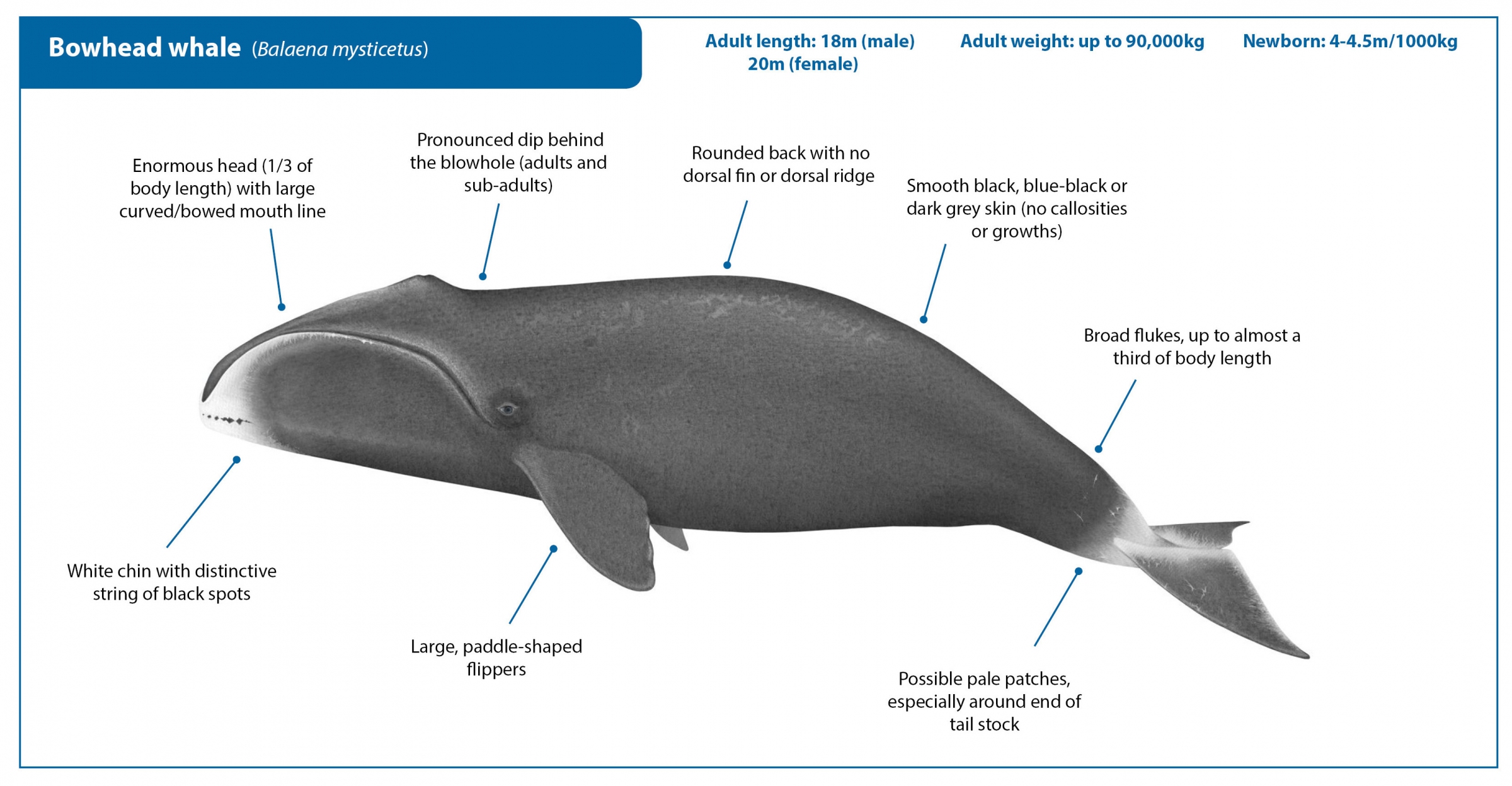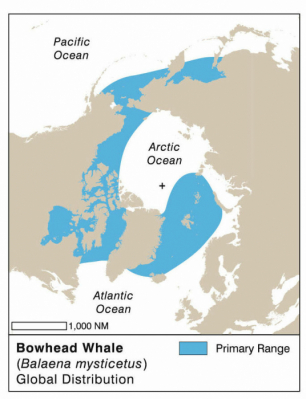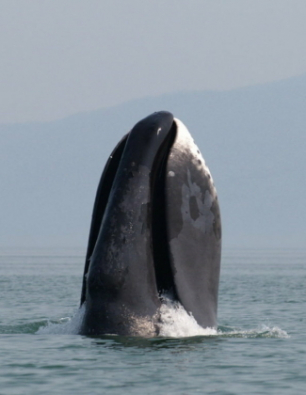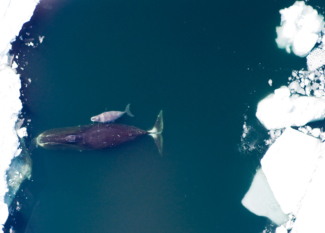Bowhead whales are supremely adapted to a life cycle spent entirely in the freezing, or near-freezing waters of the Arctic and sub-Arctic. Found in both northern Atlantic and Pacific waters, the species has evolved thick skin and blubber for insulation and a source of energy reserves, an enormous, strong and bowed head that can break through ice up to 1m thick, and an ability to stay under water for over an hour at a time to swim beneath the ice 1,2. Although the bowhead is not the largest whale species, it is one the heaviest, and certainly the longest-lived. Evidence suggests that individuals can live up to 150, and perhaps even as long as 200 years2-4!
Once referred to as the ‘Greenland whale’, or the ‘Arctic right whale’, few commercial whale watching operations target this species because of its mostly remote habitat. However, because it is a predominantly coastal, shallow-water species, it can be viewed from shore in some parts of its range. Although not available to commercial whale watching, one of the longest standing population research projects on this species counts passing whales from an observation perch on a pressure ridge from the edge of shorefast ice in northern Alaska 5,6. The bowhead whale is also one of the few whale species still subject to an ongoing aboriginal subsistence hunt, managed by the International Whaling Commission.

 Bowhead whale surfacing
Bowhead whale surfacing
Download Bowhead Whale Factsheet
References
Show / Hide References
- Jefferson, T. A., Webber, M. A. & Pitman, R. L. Marine Mammals of the World: a Comprehensive Guide to their Identification. Second Edition. (San Diego: Academic Press, 2015).
- George, J. C., Rough, D. & Suydam, R. in Encyclopedia of Marine Mammals Vol. Third Edition (eds B Würsig, J.G.M. Thewissen, & K.M. Kovacs) 133-135 (Academic Press, Elsevier, 2018 ).
- George, J. C. & Bockstoce, J. R. Two historical weapon fragments as an aid to estimating the longevity and movements of bowhead whales. Polar Biology 31, 751-754, doi:10.1007/s00300-008-0407-2 (2008).
- Rosa, C. et al. Age estimates based on aspartic acid racemization for bowhead whales (Balaena mysticetus) harvested in 1998–2000 and the relationship between racemization rate and body temperature. Marine Mammal Science 29, 424-445, doi:10.1111/j.1748-7692.2012.00593.x (2013).
- Barrow, Alaska. Marine Mammal Science 20, 755-773 (2004).
- Givens, G. et al. Estimate of 2011 abundance of the Bering-Chukchi-Beaufort Seas bowhead whale population. document presented to the Scientific Committee of the International Whaling Commission SC/65a/BRG01, 30 (2013).
- Fortune, S. M. E. et al. Seasonal diving and foraging behavior of Eastern Canada-West Greenland bowhead whales. Marine Ecology Progress Series 643, 197-217 (2020).
- Schell, D. M., Saupe, S. M. & Haubenstock, N. Bowhead whale (Balaena mysticetus) growth and feeding as estimated by δ13C techniques. Marine Biology 103, 433-443, doi:10.1007/BF00399575 (1989).
- Finley, K. P. Natural History and Conservation of the Greenland Whale, or Bowhead, in the Northwest Atlantic. Arctic 54, 55-76 (2001).
- Lowry, L., Sheffield, G. & George, J. Bowhead whale feeding in the Alaskan Beaufort Sea based on stomach contents analyses. Journal of Cetacean Research and Management 6, 215-233 (2004).
- Heide-Jørgensen, M., Garde, E., Nielsen, N., Andersen, O. & Hansen, S. A note on biological data from the hunt of bowhead whales in West Greenland 2009–2011. Journal of Cetacean Research and Management 12, 329-333 (2012).
- George, J. C. et al. Age and growth estimates of bowhead whales (Balaena mysticetus) via aspartic acid racemization. Canadian Journal of Zoology 77, 571-580, doi:10.1139/z99-015 (1999).
- Rugh, D. J., Miller, G. W., Withrow, D. E. & Koski, W. R. Calving Intervals of Bowhead Whales Established Through Photographic Identifications. Journal of Mammalogy 73, 487-490, doi:10.2307/1382014 (1992).
- Clark, C. W. et al. Passive Acoustic Locations and Offshore Distribution of Bowhead Whales (Balaena mysticetus) during the spring of 2001 Census off Pt. Barrow, Alaska. 1-8 (2002).
- Blackwell, S. B. et al. Effects of Airgun Sounds on Bowhead Whale Calling Rates: Evidence for Two Behavioral Thresholds. PLoS ONE 10, e0125720, doi:10.1371/journal.pone.0125720 (2015).
- Clapham, P. J., Young, S. B. & Brownell Jr, R. L. Baleen whales: conservation issues and the status of the most endangered populations Mammal Review 29 35-60 (1999).
- Rolland, R. M., Graham, K. M., Stimmelmayr, R., Suydam, R. S. & George, J. C. Chronic stress from fishing gear entanglement is recorded in baleen from a bowhead whale (Balaena mysticetus). Marine Mammal Science 0, doi:10.1111/mms.12596 (2019).
- Thomas, P. O., Reeves, R. R. & Brownell, R. L. Status of the world's baleen whales. Marine Mammal Science, doi:10.1111/mms.12281 (2015).
- Moore, S. E., Haug, T., Víkingsson, G. A. & Stenson, G. B. Baleen whale ecology in arctic and subarctic seas in an era of rapid habitat alteration. Progress in Oceanography 176, 102118, doi:https://doi.org/10.1016/j.poce... (2019).
- Reeves, R. R. et al. Distribution of endemic cetaceans in relation to hydrocarbon development and commercial shipping in a warming Arctic. Marine Policy 44, 375-389 (2014).
- Reeves, R., Rosa, C., George, J. C., Sheffield, G. & Moore, M. Implications of Arctic industrial growth and strategies to mitigate future vessel and fishing gear impacts on bowhead whales. Marine Policy 36, 454-462, doi:http://dx.doi.org/10.1016/j.ma... (2012).
- Moore, S. E. & Huntington, H. P. Arctic marine mammals and climate change: impacts and resilience. Ecological Applications 18, S157-S165 (2008).
- George, J. C., Druckenmiller, M. L., Laidre, K. L., Suydam, R. & Person, B. Bowhead whale body condition and links to summer sea ice and upwelling in the Beaufort Sea. Progress in Oceanography 136, 250-262, doi:https://doi.org/10.1016/j.poce... (2015).
- Heide-Jørgensen, M. P., Laidre, K. L., Quakenbush, L. T. & Citta, J. J. The Northwest Passage opens for bowhead whales. Biology Letters 8, 270-273, doi:10.1098/rsbl.2011.0731 (2012).
- Cooke, J. & Reeves, R. Balaena mysticetus IUCN Red List of Threatened Species https://dx.doi.org/10.2305/IUC... (2018).
- 2Cooke, J. & Reeves, R. Balaena mysticetus (East Greenland-Svalbard-Barents Sea subpopulation). IUCN Red List of Threatened Species http://dx.doi.org/10.2305/IUCN... (2018).
- Cooke, J., Brownell Jr, R. L. & Shpak, O. Balaena mysticetus (Okhotsk Sea subpopulation). IUCN Red List of Threatened Species https://www.iucnredlist.org/sp... (2018).





